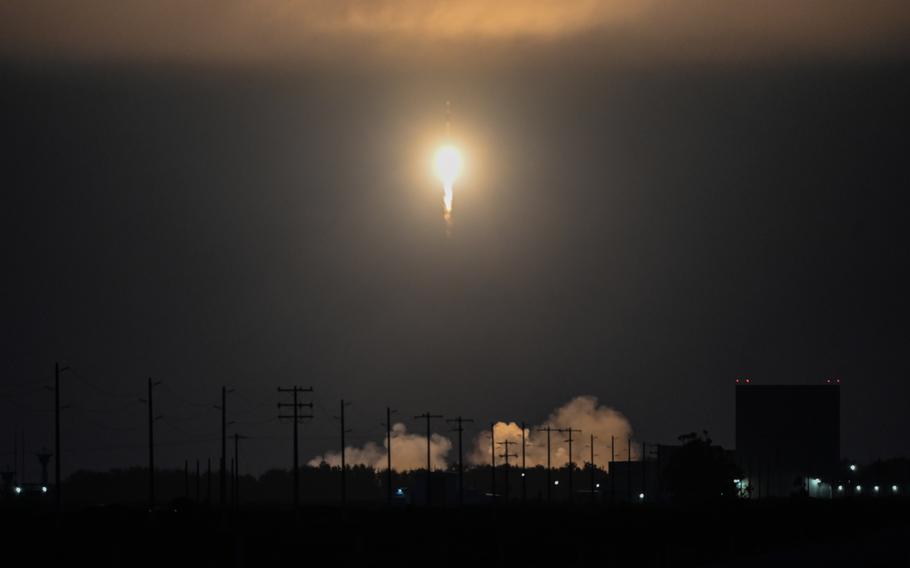
Team Vandenberg successfully launched a space vehicle for the United States Space Force into low Earth orbit aboard Firefly’s Alpha vehicle from Vandenberg’s Space Launch Complex-2, Sept. 14, 2023. (Kadielle Shaw/U.S. Space Force)
In 2018, the Defense Advanced Research Projects Agency, the small, nimble research arm of the Pentagon, challenged the space industry to do what it said “no one has done before”: launch satellites to orbit “on extremely short notice,” in an attempt to make rockets fly as frequently as airplanes.
Two years later, DARPA pronounced the effort a failure. Not a single company had been able to meet DARPA’s quick turnaround requirements — another sign of the difficulties of rocketry and just how far it is from becoming the routine service the Pentagon has long wanted it to be.
Last week, however, the U.S. Space Force took a significant step toward that goal when Firefly Aerospace, a Texas company, launched a satellite to orbit 27 hours after receiving launch orders. Space Force called it “a new record for responsive space launch.”
In a statement, Lt. Gen. Michael Guetlein, commander of Space Systems Command, said the launch “marks a culture shift in our nation’s ability to deter adversary aggression and, when required, respond with the operational speed necessary to deliver decisive capabilities to our warfighters.”
Being able to get spacecraft to orbit quickly is an important capability, Pentagon leaders have said, and something the Defense Department has been pursuing for decades. Now, as space increasingly becomes a warfighting domain, rapid response is even more important, military leaders have said, and the Pentagon is renewing its push to develop rockets and satellites that can be launched into space fast.
“Going forward, the Space Force is not going to have the luxury of time — of weeks or months to put things on orbit, or months or years to develop new capabilities,” Lt. Col. MacKenzie Birchenough, who helped oversee the program for Space Systems Command, said in an interview. “The need is a lot faster, and we look at a 24-hour type time frame as something that is realistic for us and really the goal of what we need to be getting after.”
Launching on short notice would allow the Pentagon to, say, send up a satellite that could investigate adversaries’ spacecraft, especially those getting suspiciously close to U.S. military satellites. In a time of war, it could also allow military leaders to “surge” satellites to space that could help with intelligence gathering, taking images of the ground, missile warning and communications.
The effort comes as other countries, notably China, have challenged the United States’ long-held dominance in space. China has not only demonstrated its ability to explore, putting a rover on Mars, a spacecraft on the far side of the moon and astronauts on a space station in low Earth orbit, but its military capabilities are growing as well. Just over the weekend, it launched another batch of reconnaissance satellites, according to SpaceNews, and plans more than 70 launches in total this year.
As a result, the United States is scrambling to stay ahead.
“The ability to put something up very quickly is incredibly important,” Birchenough said.
Firefly’s nearly 100-foot tall Alpha rocket lifted off from Vandenberg Space Force Base late Thursday. It carried a satellite manufactured by Millennium Space Systems, a Boeing subsidiary, that is designed to track objects in orbit.
In the first phase of the program, the Space Force gave Millennium 60 hours to transport the satellite to the launch site, fuel it and prepare it to be mated to the rocket. Then, Firefly had 24 hours to update the rocket’s trajectory and guidance software and prepare the rocket to launch the satellite. As it turned out, the launch window required to put the satellite in the correct orbit came at 27 hours, but Birchenough said the company was ready to go at 24.
That beat the previous responsive launch record of 21 days in 2021, the Space Force said.
Getting anything to orbit is difficult, and doing so quickly is even more so. Typically, it can take months, or even years to prepare a satellite and the rocket, and even then there are often delays and sometimes failures. On Tuesday, for example, a Rocket Lab Electron rocket failed as it was delivering a radar satellite for Capella Space designed to take images of Earth.
Other companies, such as Virgin Orbit, one of the contestants in the DARPA competition that had promised to meet the Pentagon’s responsive needs by launching its rocket from the wing of a 747 airplane, have gone out of business.
Bill Weber, Firefly’s CEO, said the mission was the culmination of work not just at the company but of the industry as a whole, which has matured rapidly. Many of his engineers, he said, have come from other companies, such as SpaceX, and brought what they learned to Firefly.
“You have to give credit where it is due,” he said. “If the sector hadn’t learned the lessons, and the data from those lessons hadn’t been made available, I don’t think Firefly could have done what we just did. And so it would be inaccurate, and a little arrogant, to suggest we did it from scratch.”
As the industry continues to evolve, he said, rapid response should become the norm.
“I don’t think 24 hours is even close to what the industry will be capable of,” he said. “I think there will continue to be a push to do the things that can be done in rapid succession faster and faster and faster.”